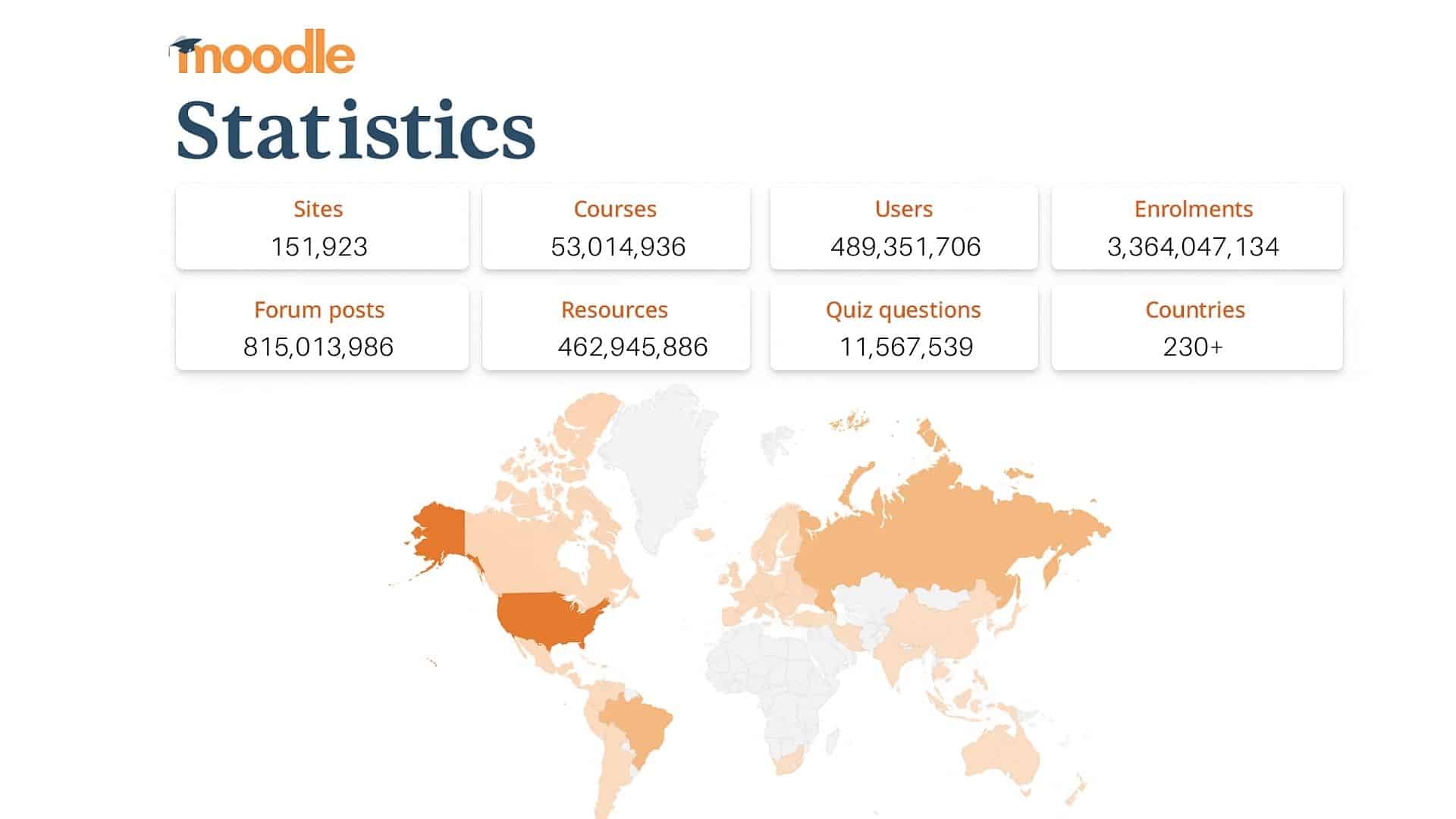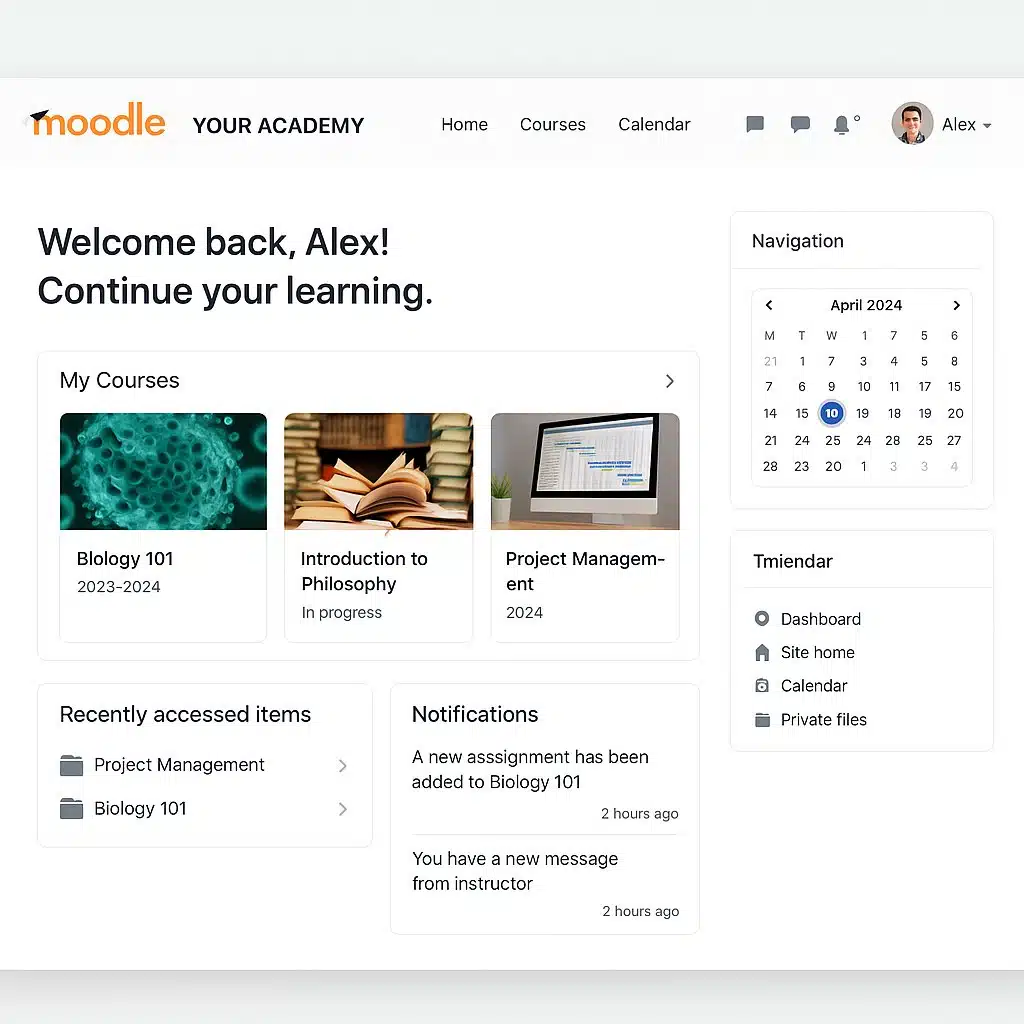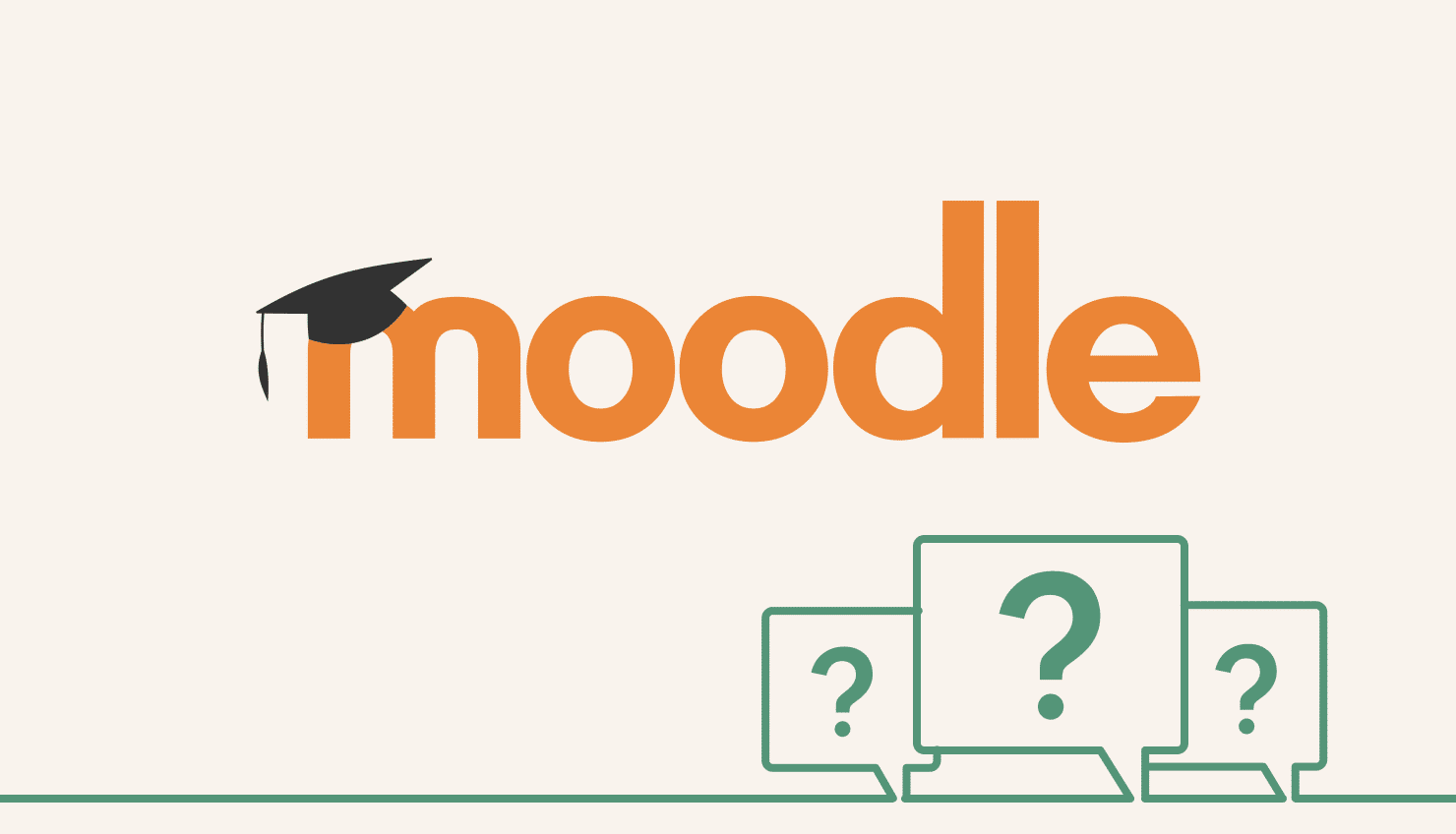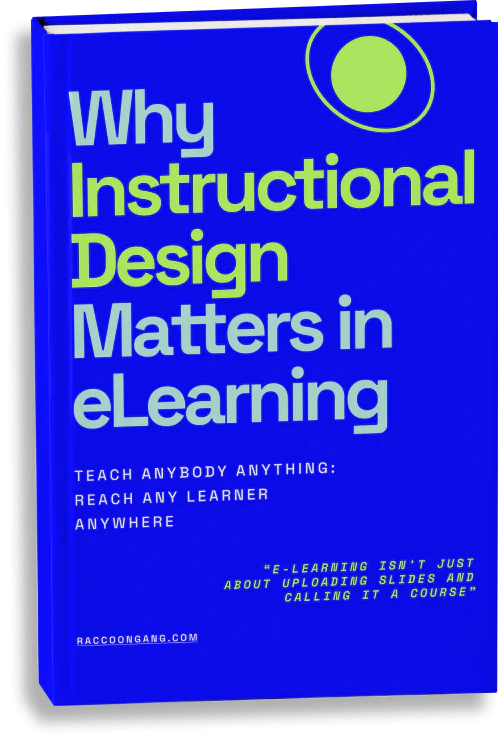To answer the question “What is Moodle,” it’s not enough to just mention Moodle LMS software. The situation is far more interesting. If you’ve ever taken an online course, there’s a good chance it was powered by Moodle, isn’t there? That’s why it’s one of the most popular learning management system platforms.
In this article, you’ll find useful information about key features, benefits, pricing, and real use cases of Moodle in schools and businesses. Here are the gems we’ve gathered especially for you. Let’s get started.

Global Moodle LMS statistics highlight its worldwide reach with over 489 million users, 152,000+ active sites, and a presence in 236 countries.
Moodle Meaning and Overview
To put it bluntly, Moodle is a learning management system that gives organizations full control over their online learning environment.
If the LMS platform is the foundation for online learning, then Moodle software is the framework that lets you build and manage it your own way. But let’s look at all these things in turn.
What is LMS platform? This abbreviation you’ve certainly come across stands for Learning Management System. In other words, an LMS is software that helps create, manage, and deliver online courses and training programs. Based on that, the answer to the question “What is Moodle software?” becomes clearer. But Moodle isn’t just another LMS. It always stood apart. First, it’s open-source — the code is free and accessible. Second, the numbers speak for themselves:
- Over 400 million people learn on Moodle-based platforms in 230+ countries.
That’s not by chance. Its features and benefits fully justify this scale. And we’ll cover them next. Stay with us.
“I’ve been using Moodle for the past five years with more than 400 students. It’s a robust system — I’ve never lost work, and my students have never reported issues,”
— an instructor experienced with Moodle LMS.

Moodle LMS homepage example showing a personalized learning dashboard with courses, notifications, and calendar integration.
Key Features of Moodle LMS Software
The Moodle learning management system is packed with tools that help organizations manage every part of online education — from course creation to learner engagement.
1. Course Management and Delivery
One of the benefits of choosing Moodle is its comprehensiveness. Course creation, editing, and management — all happen inside the LMS. Teachers can customize the course structure. Administrators can track student progress right from the course page. Tools like My Courses, Calendar, and Timeline are built in.
2. Assessments, Grading, and Certificates
Testing and evaluation are simple. Moodle includes question banks, a gradebook, and peer review options. Completion certificates are available through plugins like Custom Certificate.
Teachers save time. Learners always know where they stand.
3. Communication and Collaboration
Forums, chats, and built-in messaging keep learners connected. Students discuss ideas and ask questions. Feedback comes in real time. Notifications and reminders help everyone stay on track.
4. Analytics and Reports
Moodle tracks everything. You get site logs, activity reports, and completion data. Need deeper analytics? Use plugins like IntelliBoard to visualize learning progress and performance trends.
5. Plugins and Integrations
Thousands of plugins expand Moodle’s functionality. Video calls, analytics, authentication, or design — it’s all possible. Each organization builds what fits its own learning process. That’s real flexibility.
6. Mobile Compatibility
The official Moodle app keeps learning within reach. Learners access courses and track activities on any device. Notifications arrive instantly. Offline mode works when there’s no internet. Perfect for global teams and remote schools.
7. Roles and Administration
Moodle defines clear roles — admins, teachers, students, and custom ones too. Each role has the right permissions. The unified admin panel handles setup, branding, and user management. Everything stays under control.
Who Uses Moodle? Moodle in Education and Business
The organizations provide ongoing training. The universities offer online courses. Schools provide distance learning. NGOs train volunteers. In all of these scenarios, organizations and institutions can and do use Moodle LMS.
Education
Moodle in schools is common worldwide. What exactly is Moodle used for? As we mentioned above, K–12 institutions, small colleges, and vocational centers choose Moodle as a platform to host their own courses. As the platform’s users, including teachers, students, and administrators, note, Moodle is designed to manage lessons, assignments, and grades in one place.
If you want to learn how LMS solutions are implemented for schools, check out our K–12 Learning Management System. For higher education institutions, our Custom Higher Education LMS page provides more details on how universities benefit from scalable, flexible LMS setups.
NGOs and Nonprofits
When it comes to socially relevant educational initiatives and programs, Moodle also often figures here. A simple example: nonprofit organizations use Moodle LMS for rural outreach and community education. In turn, healthcare NGOs provide access to training for their specialists in remote areas.
Corporate Learning & Development
It’s no secret that corporate learning and L&D, in particular, are increasingly being budgeted for in organizations. Moodle, with its plugins, SCORM support, gamification, and analytics, comes in handy for internal HR training, onboarding, and compliance.
Government Institutions
Moodle is not hiding in the shadows when it comes to employee upskilling and policy training. Government departments trust Moodle’s security and reliability.
“When people ask who uses Moodle, the answer spans far and wide. Schools, universities, and global companies rely on it to deliver flexible courses and professional development anytime, anywhere.”
— LMS architect at Raccoon Gang.
Compared with Open edX, Moodle tends to attract smaller or medium-sized organizations. It’s easier to deploy, lighter to maintain, and ideal for blended or self-paced learning. Open edX, in contrast, is often chosen by large-scale universities and enterprise-level training projects.
Moodle LMS Pricing & Setup
We’ve already mentioned that Moodle is free — and that remains true. It’s open-source software with no license fees. Anyone can download, install, and customize it without paying a cent.
However, Moodle LMS pricing is not only about the code. Things like hosting, maintenance, and support are necessary for the instance to function. Therefore, we offer you more details regarding the potential costs of Moodle LMS software.
1. Self-Hosted Moodle
Does your team have technical skills and free hours? The self-hosted model is what you need in such a situation because server setup, data security, and updates will all be controlled by your specialists.
- You run Moodle on your servers or cloud.
- You control performance and security.
- You handle upgrades and support.
- Total cost depends on staff time and infrastructure.
2. Managed Moodle Hosting
Are you looking to launch a course with a minimal set of functionality as quickly as possible? Schools and businesses will definitely appreciate this model because the provider takes on all the responsibilities for hosting, maintenance, and backups.
- A provider runs Moodle for you.
- You pay a monthly or annual fee.
- They handle uptime, scaling, and updates.
- You focus on courses and users.
By the way, the same situation applies to other similar platforms. For example, Open edX hosting is in the list of services from Raccoon Gang.
3. Add-on and Support Costs
To give you a clear idea of pricing models and potential costs, it is important to note potential extra expenses. Premium plugins, custom themes, and dedicated support are all important and will improve both your experience and your students’ experience when working with the platform. However, this will require an additional budget, of course.
- Premium plugins or integrations.
- Theme design and branding.
- Single sign-on, analytics, or proctoring.
- Priority support or admin training.
While Moodle itself is free, Moodle LMS pricing depends on how it’s deployed. Self-hosting gives full control but requires technical effort. Managed hosting offers peace of mind and predictable costs — ideal for organizations focused on learning outcomes rather than server management.
Advantages and Limitations of Moodle LMS
| Category | Strengths | Challenges |
| Flexibility | Highly customizable. Thousands of free and premium plugins. | Too many plugins can cause compatibility issues. |
| Cost | Open-source. No license fees. | Hosting, maintenance, and support still cost money. |
| Community | Global community with constant updates and resources. | Hard to find consistent guidance or expert-level support. |
| Setup | Easy to start for small institutions. | Complex for scaling or integrating advanced systems. |
| Maintenance | Frequent security updates and active development. | Upgrades may break older customizations. |
| User Experience (UX) | Familiar interface for educators and students. | Interface can look outdated without theming. |
How Open edX LMS Differs
As an LMS development expert with over 10 years of experience, Raccoon Gang has worked with both Moodle and Open edX® on more than 200 projects. Main differences that set Open edX apart:
- Built-in scalability — designed for large institutions and enterprise use.
- Advanced analytics is possible through integrations and extensions.
- Structured learning flow with videos, quizzes, and progress tracking.
- Professional theming options, though changes require technical setup.
- No native messaging or unified calendar — relies on plugins or integrations.
- Role-based structure supports large authoring and admin teams.
- Certificates and grading are handled directly within the platform core.
“In our experience, Moodle stands out for its flexibility and affordability, while the Open edX® platform proves unmatched in scalability and advanced course delivery.”
— Raccoon Gang LMS Expert.
Conclusion
Thank you for reading our material. We hope that at this stage, you have answered the questions you had before.
What would you like to add? Like any investment choice, choosing between Moodle, Open edX®, or any other LMS is a strategic one. Last advice for today — before you decide which LMS to move forward with, ask yourself:
- What are my current and future user numbers?
- Do I have an internal IT team or prefer a managed solution?
- How important are analytics, scalability, and integrations for my goals?
- What’s my long-term plan for content updates and platform growth?
If you plan to upgrade your platform or switch to another LMS, don’t do it alone. Expert help makes it simple and safe. Our team manages Open edX migration services with care — smooth data transfer, reliable setup, and performance built for your learners.
FAQ
What is Moodle LMS software used for?
It’s a tool for teaching online. You can build courses, assign tasks, and track results. Simple for teachers, clear for learners.
Is Moodle free or paid?
The software itself is free. But you’ll pay for hosting, setup, or support if you don’t have an IT team.
Who uses Moodle learning management system?
Mostly schools and universities. But also NGOs and companies that train people regularly.
How much does Moodle LMS pricing cost with hosting?
Depends on the setup. Self-hosted costs less but takes time. Managed hosting costs more but saves effort.
Is Moodle good for schools and education?
Yes. It’s built for education. Reliable, flexible, and proven by millions of learners.




